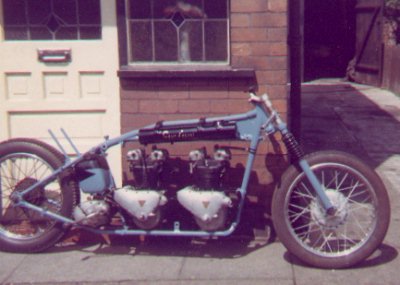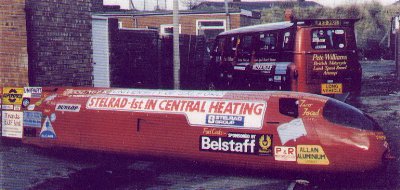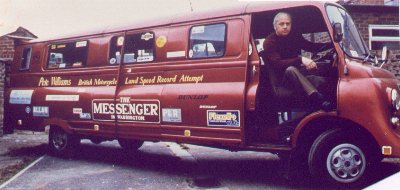Pete Williams, a former Secretary of the National Sprint Association, gives
a brief history of himself and the NSA
Pete Williams is single and an electrician by trade, and has devoted most of his life to his sport. He began
sprinting in 1964 at age 23 - he had been building a 1000cc double-engined Triumph for use on the road,
using two iron-head Triumph engines, but then he read about sprinting in the motorcycle magazines of the time and
decided to have a go at this instead.
|

Coup d'essai
|
Pete had originally planned to use two 650cc engines but found that the maximum capacity limit for sprint bikes
was 1000cc at that time, so fitted two 500cc engines instead. He had joined the NSA in 1963 and his first meeting
on the 1000cc double-engined Triumph (named Coup d'essai - French for 'A First Attempt') was at RAF Topcliffe in
Yorkshire. After tow-starting the beast with a rope a fuel-tap came off the fuel tank (the threaded-
boss of which had been soldered on) and put an end to that first meeting.
|
Top
By the time he was 27 in 1968 he had become one of the three quickest sprinters in Europe on the legendary double-engined
Triumph Two Faced. He continued to sprint and did the odd drag-meeting in those early
days, racing at Duxford, Topcliffe, Martlesham (near Ipswich -- now an industrial estate), Graveley, Santa Pod,
Wroughton, Elvington, Esholt Park, Fulbeck and other venues. Eventually a speed wobble at around 120 mph threw
him from Two Faced at Elvington in 1977, badly damaging the bike and leaving Pete on crutches for about a week.
At that time Pete was self-employed making alloy fuel-tanks for sprint/drag bikes and many of the road-race stars
of that time, and even exported a few tanks to Canada and Australia.
|

The streamlined speed record attempt machine
|
Pete was also becoming involved in a Land Speed project which began to consume much of his time. He had inherited
the semi-detached in which he had lived all his life from his parents, and continued to live there at Padgate for
a few more years before selling the house to raise capital for his land speed record project. In the 1980's he
went to live in a derelict terraced house he bought for £2,750 so you can tell what condition it was
in! Pete began working on the construction of a totally streamlined machine to attempt first the UK and then the
World record, initially planning to use three Triumph twin-cylinder engines before switching to jet or rocket depending
on finances (which were very limited!)
|
|

The stretched Leyland van
|
He also extended a British Leyland van to a length of 22 feet six inches and fitted a 3.5 litre Rover V8 engines
to use as a transporter for the streamliner machine. Building the van alone took him ten months of full time
work. He had given up his job, refusing to draw dole and living off his fast-dwindling savings and small amounts
of sponsorship money.
|
Top
Pete and the NSA
The National Sprint Association was formed in 1958 after meetings between enthusiasts at the Red Lion pub in
Rosoman Street, London EC1. In 1959 the club was fully recognised and affiliated to the ACU, and from 1961 headquarters
were at the Barley Mow in Westminster. During the middle sixties the NSA President was the late great Donald Campbell
CBE, who had held both the World Land Speed and the World Water Speed records. Tragically he was killed in January
1967 whilst trying to raise the World Water Speed record to 300 mph. He almost succeeded in doing this clocking
297mph on his first run, but his jet-boat Bluebird took off at around 300mph on his second and return run. NSA
President for many years was one of our greatest sprinters, the late George Brown who sprinted his Vincents Nero,
Super Nero and Extra Nero, and also an Arial Arrow. He tragically succumbed to heart problems many years later.
Pete became secretary of the Northern section of the NSA back around 1977. The maximum capacity limit had by
then been raised to 1300cc to allow the American double-engined Triumphs to compete in the drag festivals of the
mid-sixties. Pete thought that the limit should be higher because Americans were coming over with double-engined
Harleys and were limited to demonstration runs only. Ever the innovator, Pete campaigned with the Auto Cycle Union
(ACU), who control all UK motorcycle sport, to get the limit raised to 3500cc and was successful in this. Since
then Graham Sykes has managed to get an 'open' capacity limit because his own bike SYKO is over 3.5 litres, but
these-machines are limited to being UN-blown. Also around 1978 Pete introduced the Junior sprint classes; for the
very first time allowing youngsters to compete in sprints. Again he had pressured the ACU and consulted with his
NSA colleagues in setting up the first junior classes, which were originally limited to 50cc bikes. However they
have now flourished and diversified into several different junior classes which are keenly contended.
In the early eighties the NSA Executive committee, which had hitherto always been in the 'South', moved to the
North for the first time and Pete Williams took over the job as NSA Executive secretary. He held this post until
around 1989/90, by which time he had been a secretary (including originally Northern sec) for some 12/13 years!
Possibly the longest-serving secretary before that would have been the late Jack Terry, one of the original members
from the early days.
Top
Recent years
Pete Williams continued as an ordinary NSA club member after relinquishing the Secretary's job around 1990,
but was almost out of cash by then and his streamliner project had come to a grinding halt. Pete renovated his
terraced house and put it on the market, selling it in 1991. He moved to an industrial building and used a small
part of the workshop where a friend was running a small motorcycle business. Unfortunately a year or two later
the friend closed his business and moved out, leaving Pete with no other option but to take on the tenancy and
try to make it pay. It was costing him over £1,000 every twelve weeks for rent ALONE! The writing was on
the walls - suffice it to say that Pete struggled on through the nineties with his cash virtually gone and almost
bankrupt.
He resurrected TWO FACED in 1996 to get back into some action and also to raise awareness of his other projects
including a new sprint machine using Kawasaki power. He made a triumphant return at North Weald on 16th June 1996,
smoking the rear tyre of TWO FACED (now some 28 years old INCLUDING THE TYRES) and finishing around tenth out of
226 machines on a bike he had not ridden for over 18 years! Many people thought that because Pete had not appeared
since his 1977 Elvington crash he had lost his bottle, but that was shown to be a total red-herring after his return
at North Weald in 1996.
Pete had to leave the industrial premises in 1997 with no capital and no workshop, and with his machines and
belongings scattered all over the place. He ended up in a council flat, an upstairs one with nowhere to put a garage.
Because of illegalities perpetrated against him whilst at the industrial unit Pete had taken legal action against
various parties (NOT his friend he hastens to add). These were causing him stress and in February of 1998 he suffered
a heart-attack at his flat in Culcheth near Warrington. Not having a phone, he managed to get to his feet and stagger
down the stairs and asked a neighbour to call an ambulance. He spent a week in intensive care and spent some months
recuperating, though still experiencing some angina.
Pete immediately set about getting fit again. He managed to convince both the doctors (who were aghast at him
wanting to return to racing) and the ACU (who had never heard of anyone doing so after a heart-attack) to allow
him to race again. He proved his fitness to them by doing tests on the ECG./Treadmill to the Bruce Protocol standard.
Pete has now ditched his Beta-blocker tablets and other medication and is just on a daily dose of aspirin. In August
of 1998, just barely six months after his heart-attack, he was back again at North Weald. He did the 400 mile round
trip and went through all the bike and race preparation, including butterflies, with no ill-effects. Unfortunately
TWO FACED once again lived up to it's name and blew the rear engine in a big way on a 95% nitro dose.
Pete returned home, stripped the bike in the back of a van, and moved the various parts into his BEDROOM ready
for re-building. However not too long after that Pete got a move to a downstairs flat with a large rear garden,
and subsequently got permission to build a garage there. One of his court-cases had by that time come to fruition
and brought Pete enough funds for him to buy building materials. He lay down a garage-base and erected concrete
sections, doing most of the work himself including the digging of an inspection-pit. TWO FACED is now ready for
yet another re-build!
If nothing else this is a story of dogged determination. Pete feels that it would be nice if he could get a
little financial help towards the expensive running costs of TWO FACED, and the construction costs of completing
his Kawasaki sprint/dragbike and his land speed record streamliner machine. For the last venture he ALREADY NOW
HAS a Rolls Royce Viper JET-ENGINE!!!


